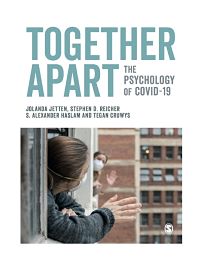Social Isolation Amid COVID: An Excerpt from ‘Together Apart’
They had been sentenced, for an unknown crime, to an indeterminate period of punishment. (Camus, 1947)
As Albert Camus observed in The Plague, quarantine is more than just ‘staying home’ — it feels like a punishment, and can take a significant toll on people’s health. The impact of social disconnection on both quality of life and lifespan has long been known. In particular, pioneering research by Berkman and Syme (1979) found that people who lacked social contact lived far shorter lives than those who were well connected — even when controlling for other obvious determinants of longevity, such as physical health, health behaviours (e.g., smoking), and use of health services.
In less morbid epidemiological research, Cohen and colleagues found that people with more diverse social networks were in fact significantly less susceptible to the common cold (Cohen et al., 2003). Indeed, among people exposed to the common cold, the least sociable were twice as likely to become ill as the most sociable. More recently still, a meta-analysis of studies including more than 350,000 people (Holt-Lunstad et al., 2010) found that the effect of social isolation on life expectancy was comparable with the effects of smoking. But it is not only physical health that is impacted by a lack of social connection. Research has also shown that the association between social isolation and health is particularly strong for mental health, with robust associations with depression, anxiety, and substance use (e.g., Ingram et al., 2020).

Though many people may have previously been unaware of social isolation’s adverse effects (Haslam, McMahon, et al., 2018), these may now have been brought home by their personal experiences of living under lockdown conditions. Moreover, as isolation became the norm rather than the exception, so too do did its health consequences. Indeed, Google registered a global spike in searches for ‘isolation’ and ‘loneliness’ beginning in mid-February 2020 (Google Trends, 2020). At the same time, suicide-crisis phone lines around the world reached their highest ever demand (Neal, 2020). In the face of COVID-19, many people who had never experienced significant mental health difficulties before found themselves struggling with insomnia, anxiety, and emotion dysregulation for the first time.
In this context, one important question to ask is whether the link between social isolation and ill-health is merely an association, or whether feeling isolated causes poor health. This issue was explored in a series of studies prior to the COVID-19 outbreak. For example, one study followed a large and representative sample of over 21,000 New Zealanders across a five-year period, tracking changes in their social connectedness and mental health (Saeri et al., 2018). People who experienced a drop in their degree of social connectedness were at elevated risk of a decline in their mental health one year later. The relationship also went the other way: people who experienced a decline in their mental health tended to become more isolated one year later. Importantly, though, the former relationship was about three times stronger than the latter. This suggests that people are more likely to lose social connections prior to mental health decline, rather than the other way around.
Interestingly, we are better able to respond to the challenges that life throws our way when we simply reflect on our social connections — in particular, on the social groups that we belong to. In one experiment, prior to completing an unsolvable problem-solving task, half of the participants were asked to reflect on the many groups to which they belonged while the other half were not. When faced with failure on the task, the former participants were subsequently less distressed — pointing to the capacity for valued group memberships to protect mental health in trying circumstances (Cruwys et al., 2015).
Critically, what this large body of evidence indicates is that the extended and widespread period of social isolation brought about by the COVID-19 lockdown is likely to have significant and serious impact on health — especially mental health. Our goal here is not to question the medical necessity of stay-at-home orders, or their role in reducing demand on hospitals. Instead, we seek to highlight that there are also public health costs of such policy, particularly for mental health. Crucially, we also illustrate how the negative effects of social isolation might be mitigated, which is of enduring relevance not only during the COVID-19 crisis but also in building an inclusive and healthy society in its aftermath.
Isolation will hit some harder than others
A large body of research has examined people’s capacity to navigate significant life changes — for example, those associated with parenthood, retirement, and entry into higher education. In every case, findings suggest that positive connections to others are a source of psychological resilience that helps people negotiate the transition successfully (Haslam et al., 2020). However, unlike most life changes, COVID-19 has required people to drastically reduce social contact to combat the pandemic. This is likely to have been particularly disruptive to people’s capacity to maintain social connections and hence their ability to cope with the challenges the virus presents. One particular group at elevated risk is older people ( the focus of Chapter 10). More worryingly still, those whose level of social connection was already low are at a heightened risk of severe isolation, and its negative health consequences. Indeed, it is clear that the pandemic has disrupted the fragile circumstances of millions of people already living with challenges such as mental illness, domestic violence, or homelessness. For example, within a month of physical distancing measures being put in place, countries around the world saw a spike in demand for social services such as domestic violence support (Taub, 2020).
Data collected in late March 2020 with 536 U.K. residents shows that the pandemic situation is much more difficult for those already at risk (Bentley et al., 2020). At this time, people in the U.K. were experiencing the phased introduction of physical distancing, but had not yet gone into full lockdown. The survey focused on key outcomes that are essential not only to the people experiencing the challenges of COVID-19, but also to those trying to lead them through it: access to knowledge, preparedness for self-isolation, feelings of trust, and a sense of community cohesion. The findings suggest that people with the lowest levels of social support were those least likely to rate their access to information as adequate, to feel that others were behaving responsibly, or to feel that their community was cohesive. They were also more likely to express concern about their capacity to cope with self-isolation. By contrast, those who reported feeling more connected to others consistently reported having more trust, better access to relevant information, and felt their community was more cohesive.Most dramatically, those who were in the loneliest 10% of the sample were eight times more likely to report clinical levels of psychological distress than those in the least lonely 10% of the sample.
We can only be ‘together apart’ by building community and belonging
To understand how people can stay together while apart, it is important to consider why social isolation proves to be such a powerful trigger for ill health. The answer lies in the key insight that humans are fundamentally social beings who derive a sense of self (and everything that goes with it — e.g., self-worth, self-efficacy) from their group memberships. The social identities we derive from our group memberships allow us to leverage social support and furnish us with a sense of purpose and control — all critical resources of our health (Jetten et al., 2014). This means that social activities are not simply an ‘optional extra’. Rather, in allowing us to live out our social identities, groups are crucial to healthy psychological functioning. For example, it is not enough to merely attend a choir rehearsal to reap the benefits of being a chorister. Instead, you need to feel a sense of belonging to your choir. Many recommendations for how to stay connected miss the mark because they do not focus on the central role of social identities. Some are preoccupied with the medium of social contact, for instance, in emphasising the need for face-to-face or video contact, rather than phone or message-based contact. Other misguided advice risks a preoccupation with the amount of social contact, imploring people to have daily contact or else risk a decline in well-being. What both such recommendations miss is an understanding of the psychology of isolation. A social identity perspective instead reveals that the crucial ‘ingredient’ in social relationships that makes them so beneficial for health resides is neither the format nor dosage. Instead, it is the subjective sense of belonging to some greater collective that is crucial. To the extent that people feel that they remain connected to meaningful communities during lockdown — either through virtual or other means — they will be relatively protected (see also Chapter 10).
Given what we know about the risks of isolation and who will be most affected, the critical question is therefore what can be done to reduce the impact of stay-at-home orders, especially for those who are most vulnerable. The most important principle is that physical distance does not preclude social connection. Modern technology enables people to stay connected without risking infection in ways that would have been impossible even 10 years ago. Indeed, this insight contributed to the World Health Organisation’s decision to drop the term “social distancing” (Greenaway, Cruwys, & Saeri, 2020).
Structured interventions may also be able to help people stay connected. Prior to the COVID-19 pandemic, social identity researchers had developed an intervention known as Groups 4 Health (G4H) to address social isolation. Importantly, G4H has been evaluated in randomised controlled trials and shown to reduce loneliness, depression and anxiety (Haslam, Cruwys et al., 2019). However, G4H is a face-to-face program, and in the world of COVID-19 this makes it hard to implement. Interventions such as this must therefore be adapted to suit a remote context. Groups 2 Connect is an online adaptation of G4H that raises awareness of the impact of connectedness, and focuses realistically on what people can do within physical distancing requirements to maintain a sense of connection to others. Initial evidence suggests that, like G4H, this is beneficial for connectedness and well-being.
More generally, the pandemic has produced some heart-warming examples of people maintaining community despite isolation. People singing together from their apartment balconies in densely populated areas of both Wuhan and Milan (Taylor, 2020); online cooking classes connecting people to their cultural heritage; orchestras and bands co-producing rousing anthems from separated sites (Asprou, 2020; Lam, 2020). There are also reports of a huge growth in neighbourhood-based social media groups, as well as a global rise in cooperative online gaming (Moody, 2020). Each of these examples showcases innovative solutions to the problem of remaining connected. They also speak to the fact that while groups have historically been portrayed as toxic, the data actually suggest the opposite is true. It would seem that protecting people against the toxic effects of isolation needs to centre on the key thing that they are being denied — meaningful group-based connection. Indeed, finding ways to be together apart needs to be a core part of the COVID-19 response.
Explore the section of Together Apart on social (dis)connectedness
Group Threat and COVID| Katharine H. Greenaway
Risk Perception Amid COVID | Tegan Cruwys
Social Isolation Amid COVID | Sarah V. Bentley



























































































